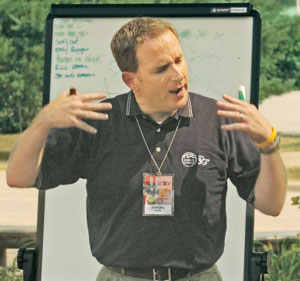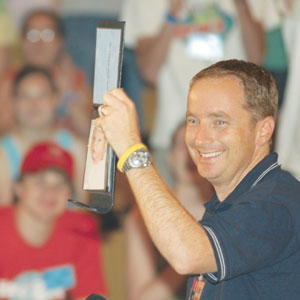Scott Lang has become one of the most vibrant speakers and authors on the subject of developing student leaders. He is a dynamic force whether training a handful of student leaders in a single band or presenting to a large crowd at the Midwest Clinic. I first met Scott in the mid-1990s when we were both band directors in the East Valley region outside of Phoenix. He has been a very successful conductor and teacher and even had a brief stint as an administrator, which thoroughly convinced him that he was better suited for the classroom. His most recent book and video series are published by GIA Publications.
What made you decide to leave administration and return to the classroom?
School administrators do important work, but the job was not a good fit for me. I struggled with the transition from working with eager music students who were the most excited about school to those who had discipline problems and were not interested in school.
How did you become passionate about teaching leadership?
Tim Lautzenheiser planted the seed for me as he has done for so many people. He isn’t just the leader of the movement; he created it. He not only started me on this journey but was also the one who encouraged me to pursue it professionally. He and I share the belief that improved leadership skills not only produce better people but better musicians as well. I draw my inspiration from a variety of people and resources, although my beliefs drive the message. When I first started talking about leadership, perhaps 90% of the material was adapted from others and 10% came from my ideas. Over time as my knowledge and experience have grown, that percentage has reversed.
How do leadership styles vary depending on the job and the program?
The demands placed on student leaders differ greatly from program to program, depending on the needs of the director and the resources of the program. Some organizations are so well-developed and have such high-quality instructional staff that they require little more than clerical work from student leaders. Other programs look to student leaders to be instructional assistants and program managers. Beyond this, each director has a different opinion on how much control to relinquish to student leaders. Blending the needs of the program, the skills of the student leaders, and the comfort level of the director is a difficult but important process. To make matters more difficult, each of these parameters changes every year.
It takes effort to match students to the right job and to develop leaders who will complement the director’s approach. I hear many directors complain that they wish their leaders did more but then have a hard time explaining what tasks they want to delegate. Many directors thrive by controlling every aspect of their program and have a hard time giving up some authority.
I learned this lesson the hard way. After 15 years of being a band director I got married and for the first time had to juggle work and family responsibilities. After band camp that first year, my booster president came in and asked me to make a list of everything I did during the day. She returned to pick up the list, and the next day walked into a band council meeting and handed out new job descriptions for the officers. It turns out that the students were capable of doing far more than I had been asking of them. When I protested, the response was direct. “Do you like being married? Do you want to stay married?” When I responded yes, she said, with some righteousness, “Good. Then it is time you started going home at a reasonable hour.”
That’s when I understood for the first time how much of my day was filled with tasks that had little to do with teaching and learning. While important, these tasks can be done just as well, if not better, by students. I was hesitant at first but learned that the delegation of such tasks as updating the music website or straightening chairs in the rehearsal room was not an opportunity to work less, but a chance to teach more. Too often in life music teachers equate the hours spent on a task with effectiveness. It’s almost as if it were a badge of honor, when it actually inhibits the growth of student leaders and the progress of the ensemble.
How difficult is it to match students to the right positions in the organization?
Directors have to make sure students understand the expectations for each job. It’s unfair to ask students to sign on to be a leader when they have no real idea of what is expected of them not just as a leader, but as a person. In my leadership teams I always look for trust, work ethic, and a sense of humor. To find leaders who matched my philosophy, I developed a quirky application that required service projects, individual studies, and an element of creativity.
My favorite part of the application simply stated “Do something that dazzles me.” The projects I received in response to this part of the application never ceased to amaze me. One student convinced composer John Williams to call me. Another talked the mayor into doing a glide step down Main Street. A student created a series of coloring books based on marching band. Perhaps one of the most memorable was a student who cut her application into six pieces and sent me on a scavenger hunt every day for six days to find all of the pieces. Beyond the energy it created for the program, it was a real-life display of the characteristics I was seeking.
In the first year I tried the application I had 25 students apply for 24 positions. That number jumped to 28 the next year and then 38. By the fourth year I had 87 applicants, essentially 90 percent of the Sophomores and Juniors who would be eligible for a leadership position in the coming school year. This is when I knew the band was ready to accomplish something extremely special. I still get excited when I think that nine out of every ten students wanted to lead.
 How long would you wait before deciding that a leadership position was not working out?
How long would you wait before deciding that a leadership position was not working out?
When a leadership assignment is not working, it can be hard for directors to admit that they have made a mistake and even harder for a student to admit he is floundering. I think it is best to be as open, honest, and direct as possible when dealing with this. I remember wrestling once with whether to remove a student leader who had many skills but frequently butted heads with me and the members of his section. I brought him in to my office for a meeting and after about 15 minutes I asked, “Are you happy in your leadership role?” He responded, “No, I’m miserable. I hate it.” We quickly made the decision to end his job. In that case it probably was my fault that I did not train the student properly about what the job would entail and who he would be working with.
When working with student leaders I focus on six areas that students need to know to be effective.
1. Purpose – An understanding of the goals of the leadership team.
2. Parameters – Clear limits of their authority as leaders and what they may or may not do.
3. Picture – A broader sense of how the program works.
4. Process – Precise descriptions of the chain of communication and how things work.
5. Performance – Success as a leader depends on how well the job is done.
6. Presence – Leaders are expected to have a strong presence in the group. If someone is talking inappropriately, student leaders should handle it.
There are many students in ensembles who are talented players but who may not see themselves as leaders. What steps can get these students more involved in leading the group?
You have to find out what students are passionate about and try to match their skills and interests with the tasks you are asking them to do. Those who are more skilled as musicians should have more musical responsibilities. Those comfortable with their people skills should be managing others. There may be some players who will never be at the top of their section but still have a good attitude and strong commitment to the organization. These folks can become great leaders if given an opportunity to be successful.

What common mistakes do student leaders make?
The mistakes students make tend to mirror those make by directors. Students will often approach things in the same way that they have been approached, so if you see something you don’t like, before correcting it, make sure your leaders didn’t learn it from you. I also find that students tend not to take initiative, which is completely understandable. We tell students where and how to sit, when and where to move, what to wear, and even how to breathe, but then as leaders we expect them to make decisions independently. In rehearsal we reward followers and often select as leaders those who were our best followers, then wonder why they on’t take more initiative. In my experience, students are more comfortable being told what to do than making a judgment call. This indecisiveness, combined with directors who are unclear about what they really want from leaders, produces a culture of inactivity.
When we taught together in Arizona, I remember your students as particularly well-mannered and respectful. How did you get students to show such appreciation for others?
It can be hard to instill a sense of humility and service in modern students. Certainly there were daily reminders of courtesy and gratitude, but I also tried to organize one activity each quarter that reminded students of how fortunate they were. We collected books for homeless children, adopted 250 Christmas Angels every year, and participated in such activities as Race for the Cure.
One of my fondest memories was when we participated in the Tourna-ment of Roses Parade. We turned the event into a fundraiser for the March of Dimes calling it, “The March for Those Who Can’t.” This gave us a great opportunity to take an honor for the band and use it to help others.
Leadership training is not just a way to build better people, it is a way to build better ensembles. When students are more engaged and involved, they are more invested in their success, as well as the program’s. Our primary responsibility as music educators is to teach music, and leadership is an important tool used in accomplishing this.
Scott Lang can be contacted via his website: www.scottlang.net.





